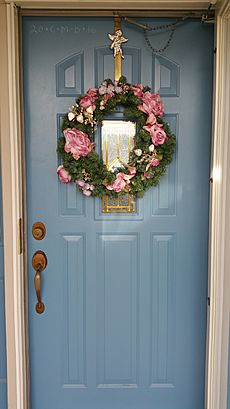Chalking the door facts for kids


Chalking the door is one of the Christian Epiphanytide traditions used to bless one's home.
Epiphany
Either on Twelfth Night (5 January), the twelfth day of Christmastide and eve of the feast of the Epiphany, or on Epiphany Day (6 January) itself, many Christians (including Anglicans, Lutherans, Methodists, Presbyterians and Roman Catholics, among others) write on their doors or lintels with chalk in a pattern such as "20 ✝ C ✝ M ✝ B ✝ 25". The numbers in this example refer to the calendar year 2025 and the crosses to Christ. The letters C, M, and B stand for the traditional names of the Magi (Caspar, Melchior and Balthazar), or alternatively for the Latin blessing Christus mansionem benedicat ('May Christ bless this house'). Another form, for Three Kings day, is to mark the door with "IIIK" (the Roman numeral three followed by "K" for "Kings").
Chalking the door is done most commonly on Epiphany Day itself. However, it can be done on any day of the Epiphany season. In some localities, the chalk used to write the Epiphanytide pattern is blessed by a Christian priest or minister on Epiphany Day, then taken home to write the pattern.
The Christian custom of chalking the door has a biblical precedent as the Israelites in the Old Testament marked their doors in order to be saved from death; likewise, the Epiphanytide practice serves to protect Christian homes from evil spirits until the next Epiphany Day, at which time the custom is repeated. Families also perform this act to represent the hospitality of the Holy Family to the Magi (and all Gentiles); it thus serves as a house blessing to invite the presence of God in one's home.
In 20th century Poland, the practice of chalking the door continued among believers as a way of asserting their Christian identity, despite the Eastern Bloc's state atheism and antireligious campaigns.
Gallery: Epiphany season door chalking
-
Epiphany door chalking in Heidelberg, Germany
-
Epiphany door chalking in Mittelberg, Austria






